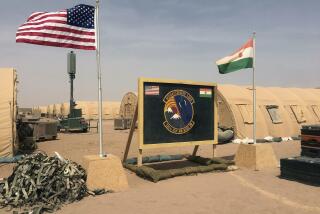U.S. Facing Crisis Over Global Military Bases : Host Nations Growing Reluctant to Allow Them, Ask More Money and Political Commitments
- Share via
WASHINGTON — The United States faces a growing crisis over its efforts to maintain a worldwide network of military bases--a crisis with far-reaching implications for American foreign policy, defense strategy and the federal budget.
Even as U.S. defense officials are identifying a growing need for overseas bases to help bring troops to places such as the Persian Gulf, foreign governments are becoming increasingly reluctant to permit American bases on their soil and are demanding more and more money and political commitments in exchange.
U.S. foreign policy has felt the squeeze.
This spring, for example, when U.S. policy-makers tried to decide how to oust Panamanian strongman Manuel A. Noriega, Defense Department officials cautioned against using U.S. military installations in Panama in a way that might suggest to other governments with U.S. bases, such as Greece and Spain, that the same thing could happen to them some day.
Whoever is elected President in November soon will find himself being urged by the Pentagon to persuade foreign governments to let U.S. forces stay in their bases and to persuade Congress to approve more money for the installations.
It probably will be up to the next President to decide how far the United States is willing to go to preserve its bases in the Philippines, the most strategically located facilities in the Pacific. The next President also will have to decide how much to ask America’s allies, such as Japan and West Germany, to contribute toward the costs of the American installations that help protect them.
In the process, the United States will have to decide whether its global system of bases fits modern-day military needs or has now become too much of a political and economic burden.
With Cold War fears fading overseas, “There’s a growing disparity between what the United States sees as the importance of its bases and what foreign governments believe is the value to them,” says James Blaker, a former Defense Department official now working for the Center for Naval Analyses.
“As the overall number of American bases has declined, the value of each one to the United States increases, and this gives each foreign government great leverage in negotiations,” Blaker says. “The issue for the future is this: What happens if we’re not willing or able to accept the costs being asked for our bases?”
Recent events already have demonstrated the pervasive nature of the base problems:
-- Spain announced in December that it will expel the largest American air unit in the Mediterranean from Torrejon Air Base near Madrid. The 72 F-16 fighter-bombers of the 401st U.S. Tactical Fighter Wing are responsible for protecting the southern flank of the North Atlantic Treaty Organization, and U.S. defense officials are now scrambling to find a new European home for them.
-- Portugal informed the Reagan Administration in February that it wants more money than Congress has been willing to approve in exchange for continued U.S. access to Lajes Air Base in the Azores. The site is a vital mid-Atlantic refueling point for planes flying from the United States to the Middle East and Persian Gulf.
-- Greece is now in the midst of testy negotiations over whether to allow the United States to continue using four bases on its soil. There have been signs that Greek Prime Minister Andreas Papandreou may ask the United States to leave the Hellenikon Air Base outside Athens, a base from which U.S. planes have conducted surveillance of Libya.
-- In the most important negotiation of all, the Reagan Administration has just begun talks with the Philippine government of President Corazon Aquino over the future of Clark Air Base and the Subic Bay Naval Base, the two largest American military installations of their kind outside the continental United States. They provide the largest American ship repair facility anywhere outside this country and a vital stop-over point for flights from the continental United States to the Middle East.
Flurry of Controversies
U.S. officials say it is a fluke of bad luck or planning that so many high-profile base controversies have cropped up in so short a time. Yet they admit that even if these current disputes are settled, there will be more in the near future. In the next few years, the United States will have to renegotiate access to military facilities in places such as Kenya, Somalia, Oman and Liberia.
“In the 1990s, the (South) Koreans will be able to defend themselves,” and the U.S. troops stationed in the country “will be there essentially for us, not for them,” says a State Department official. “. . . Will the Koreans want to charge us rent? We just don’t know. This is an issue we’re just starting to look at with them.”
Some critics of American defense policy argue that the actual value of having U.S. military outposts scattered around the world is now greatly overrated.
“Technology has changed, and the military threat has changed. I think it’s useful to rethink whether we really need a global, far-flung series of bases,” says Richard K. Betts, senior fellow for foreign policy studies at the Brookings Institution in Washington.
National Pride Issue
“Some of these bases are like the last remaining coaling stations of the American empire,” asserts William Arkin of the Institute for Policy Studies. Keeping the bases is more an issue of national pride than national security--”the question of whether America is going to keep on being No. 1,” he says.
Yet leading U.S. defense strategists maintain that in a number of ways, the overseas bases are more crucial now than at any time since World War II.
For example, one effect of the recent U.S.-Soviet agreement banning medium-range nuclear missiles is to put more emphasis on protection through conventional forces, in which foreign bases could play a key role.
“The INF (Intermediate-range Nuclear Forces) Treaty increased the importance of those F-16s” that are being evicted from Spain, one Reagan Administration official complained. “Here they are losing their home base, at a time when they have become more important to us.”
Persian Gulf Mission
A second factor is the U.S. military commitment to protect shipping in the volatile Persian Gulf. The mission dates back to President Jimmy Carter’s declaration in January, 1980, that the United States would use “any means necessary, including military force” to protect U.S. interests in the region.
With almost no bases in that region, the United States depends on transit and refueling points in Europe and Asia for getting troops and supplies there.
“Our access to the Persian Gulf has deteriorated very seriously over the years, and the Soviet access has improved,” says Albert Wohlstetter, who directed aRAND Corp. study on strategic military bases. “Another oil shock in the 1990s would cost the United States $250 billion and would cost comparable amounts for Japan and for Western Europe. It’s very hard to protect our interests if we don’t have a presence overseas.”
2,200 After World War II
At the end of World War II, the United States found itself with the most extensive network of military bases in the history of the world. The needs of that war prompted the United States to accumulate more than 2,200 overseas sites. They ran in long chains across continents and oceans--through Central and South America to Africa, across the South Pacific to Australia, through India and Burma to China.
Over the last four decades, the number has steadily declined. In a few cases, foreign governments, such as Libya and Vietnam, threw the United States out. More often, the United States voluntarily closed bases that were no longer necessary.
With the development of long-range aircraft, Pentagon planners found that they needed fewer stopover points. And with the development of satellites, U.S. intelligence agencies needed fewer listening posts on the ground.
Yet as the number of bases declined, each remaining base became increasingly valuable, both as a place to station U.S. forces overseas and for refueling and transport.
Used in Libya Raid
“Let’s take as an example our response to terrorism by (Libyan leader Moammar) Kadafi,” says Wohlstetter, referring to the U.S. bombing of Libya in 1986. “We used our F-111 (aircraft) from Britain. Without the British bases, we couldn’t have done that strike at all. We couldn’t have launched an intercontinental missile, which was irrelevant to that sort of operation.
“Some advances in modern technology enable you to reduce your reliance on overseas bases, but they sure don’t replace them,” Wohlstetter said, adding that for military purposes, “It’s just a lot easier if you have some place where you’re based nearby.”
According to a recent study by the Hudson Institute, the United States now has 759 base sites around the world--that is, facilities that either are or could be used as U.S. military installations. These bases occupy 2.4 million acres of overseas territory, approximately one-third of the acreage in 1947, and support half a million U.S. military personnel.
The first indication of problems over the bases came in 1981, when Spain negotiated a virtual quadrupling of American aid--from about $100 million to $400 million a year--in exchange for granting continued access to military bases in that country. Within a short time, then-President Ferdinand E. Marcos of the Philippines sought large increases in U.S. aid for the Clark and Subic Bay facilities, and Portugal soon followed suit.
‘Permit Costs’ Rising
Soon, foreign governments with U.S. bases began sending observers to keep track of similar negotiations in other countries. Any deal signed by the United States with one became the minimum acceptable in the next country.
The result, the Hudson Institute study concluded, was that while the building and maintenance costs of U.S. bases abroad have remained about the same, the “permit costs”--the tribute foreign governments charge for the right to use them--have increased dramatically.
The Hudson study, which was done for the Pentagon, estimated that the total costs for all U.S. bases overseas is approximately $7 billion annually, of which the United States contributes $5 billion, and allies such as Japan and West Germany contribute $2 billion.
Of the money spent by the United States, about $2 billion now goes for permit costs. Those costs include $1.5 billion to nations such as Spain, Portugal, Greece and the Philippines where the United States maintains bases of its own; and another $500 million to countries such as Kenya and Oman which grant or lease the right to use their bases.
Whose Interests Served?
Officially, the United States insists that the permit fees are not “rent,” because they are paid in the form of military aid to the countries and because American bases are said to be for the common defense of the United States and the host nations. But some of the foreign governments that have American bases are now questioning whose interests the bases serve.
“Increasingly, each one of these countries is beginning to wonder whether U.S. facilities in their countries are for them or for the United States,” says Arkin. “The Cold War may excite people in the Pentagon, but it doesn’t have the same impact on, say, Spanish Socialists.”
Officials in some of the host countries say that they have come to view the installations primarily as a symbol of the military rivalry between the United States and the Soviet Union.
“More and more Europeans consider both superpowers a threat,” said one aide to Greek Prime Minister Papandreou. “Nowhere is it stated that in order to have good relations with the Americans, you must have bases on your soil.”
Some Forfeit U.S. Aid
Such concerns have prompted some countries to demand greater financial rewards to overcome their reservations. In other cases, nations have elected to give up American aid entirely so that they can limit U.S. bases to only those they recognize as justified for a common defense.
While insisting that the United States leave the Torrejon Air Base near Madrid, Spain decided to let the United States continue using a major naval port at Rota, near the Strait of Gibraltar, and two smaller air bases and nine communications installations.
In agreeing to give up all future U.S. military aid, which totaled $110 million for Spain last year, the country followed the path of other developed countries such as Japan, West Germany, Britain and Italy, which have base sites but receive no payments.
The difficulty other nations encounter in actually getting the U.S. military funds they negotiate for base rights also plays a part in their decision to take a tougher stand on the U.S. presence.
Says U.S. Reneged on Aid
“By renouncing (U.S.) military and economic aid, we will be removing a future cyclical frustration with the United States” because Washington has failed to make good on its promises of aid, Julian Santamaria, Spanish ambassador to the United States, said in an interview. “We think it will be a much more stable relationship between the two countries.”
All U.S. security assistance for bases must be approved by Congress each year. In negotiating a sum with a foreign government, the Administration promises only to make its “best efforts” to get the money from Congress.
On occasion, particularly in the the last few years, Congress has approved less security assistance than was promised.
“We’re doing two sets of negotiations for all of these overseas bases,” said one frustrated State Department official. “One is with the country involved and the other is with Congress.”
Mideast Gets Bulk of Aid
The main reason for Congress’ behavior is its general unwillingness to spend money at a time of huge budget deficits. Another reason is that much of the money that was once available for base countries’ security assistance is now earmarked for the Middle East. In fiscal 1987, 65% of all U.S. military assistance, about $5 billion in all, went to two countries, Israel and Egypt.
“The next President will face the same dilemma that has confronted his four predecessors: how to meet the security needs of Israel and at the same time provide adequate funding for foreign assistance to other friendly states with which the United States shares important interests,” said the Center for Strategic and International Studies in a recent report.
Portugal is one of the countries hurt by the U.S. budget squeeze.
In 1983, when it signed its last base agreement with Portugal, the Reagan Administration said that it would do its best to get $125 million in military aid and another $40 million a year in economic aid for Portugal. The government of Prime Minister Anibal Cavaco Silva says that the United States also promised other aid and that Portugal expected to get $205 million annually.
Portugal’s Aid Shrank
It didn’t turn out that way. One year, in 1985, Congress gave Portugal $205 million in aid. But the aid package for Portugal dropped to $145 million in 1987 and about $115 million in the current year. During a visit to Washington in February, the Portuguese prime minister called for formal talks on the problem.
Cavaco Silva said that American aid has not reached “the legitimate Portuguese expectations” and has caused his country economic harm. President Reagan told him that Portugal and other nations with American bases must “share the pain” of U.S. budget cutbacks. The talks between the two countries are now under way.
But the problems over the U.S. bases go beyond money. U.S. officials are discovering that even if the United States could provide as much aid as foreign governments want, they would still be more skeptical of the wisdom of having American bases than they were in the past.
Spanish Prime Minister Felipe Gonzalez, whose government finally decided to give up all American aid, put it this way several years ago: “It is a question of foreign troops on our soil.”
U.S. BASES ABROAD: RECENT OR ONGOING NEGOTIATIONS SPAIN--U.S. is being required to leave Torrejon Air Base, which has housed 401st U.S. Tactical Fighter Wing of F-16 jets, largest American air unit in Mediterranean. U.S. forces will continue to use Rota Naval Base, with its strategic location near Strait of Gibraltar, as well as Zaragoza and Moron Air Bases and nine communications facilities. PORTUGAL--U.S. planes have used Lajes Air Base in Azores as mid-Atlantic stopover point for missions from continental U.S. to Mideast. In 1973, Lajes was used for airlift of U.S. weapons to Israel during Yom Kippur War. In February, Portugal asked for review of Lajes agreement, contending that Washington had promised more aid in return for base’s use. PHILIPPINES--Washington and Manila have begun talks over future of Clark Air Base and Subic Bay Naval Base, two largest U.S. bases outside United States. The two sites protect Indonesian straits, along main sea lanes for tankers from Persian Gulf to Japan, also serve as stopover point for U.S. planes and ships en route to Indian Ocean, Persian Gulf. GREECE--Reagan Administration and Greece’s Socialist government have begun talks over future of four U.S. bases in Greece: Hellenikon Air Base at Athens, Souda Bay Naval Base in Crete, Nea Makri communications base east of Athens and Iraklion communications base on Crete. Bases support U.S. operations in eastern Mediterranean and Middle East.
More to Read
Sign up for Essential California
The most important California stories and recommendations in your inbox every morning.
You may occasionally receive promotional content from the Los Angeles Times.










